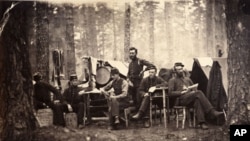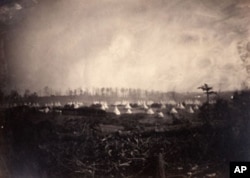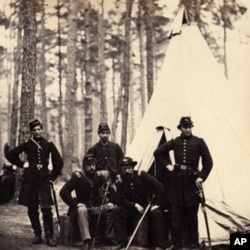Civil War photographers Mathew Brady and Alexander Gardner caused a sensation with their grisly pictures of corpse-strewn battlefields but it was a relatively unknown Vermont photographer who captured some of the most striking - though less sensational - images of the conflict.
Daily life
Traveling with Civil War troops, George Houghton managed to expertly capture the nuance of day-to-day life for soldiers.
“His composition is amazing," says historian Don Wickman. "Everything that you’re taught now about dividing pictures up into thirds, line of sight - he’s using back in 1859, 1860.”
Houghton operated a photo studio in Brattleboro, Vermont, when the Civil War broke out in 1861. He tried to enlist but was turned away for health reasons. So instead of fighting, Houghton followed Vermont soldiers to Virginia with his camera and became a pioneer in the budding field of photojournalism.
Pioneering photojournalist
“When we start looking at previous conflicts - from the French and Indian War and the Revolution, War of 1812 - photography wasn’t there," says Wickman. "So people would do oils, watercolors, pen and inks, so you had an artist’s interpretation of the scene. Photography now captured the scene as it was, bringing the war and the scenes associated with it back home.”
Wickman has gathered more than 100 of Houghton’s photographs in a new book, titled “A Very Fine Appearance.” The images are accompanied by excerpts from letters and diaries of Vermont soldiers.
There are long-range photos of union camps that show row upon row of white triangular tents tucked amidst the landscape. There are sobering scenes of men burying their comrades.
But Wickman says it’s the images of soldiers relaxing that may be the most haunting. They show the men in front of tents - their worn and dusty boots propped up on stools - fatigue etched into their young faces. Behind them, jackets and laundry hang on tent posts.
“They’re not all spit and polish. A real favorite that I have shows veterans of the 4th Vermont regiment returning at the expiration of their three year term of enlistment in 1864 to Brattleboro. They look totally opposite from the way they would have looked in September of 1861. They’re wrapped in blankets, their clothes are ragged. But they’ve just been through three full years of war and they’re showing it.”
'Arresting images'
Harold Holzer, a leading authority on Abraham Lincoln and the Civil War era, wrote the forward to Wickman’s book. He writes that “George Houghton produced some of the most comprehensive and visually arresting images of the war."
"It remains something of a mystery,” says Holzer, “that Houghton has remained all but unknown for nearly a century and a half.”
While Vermont soldiers fought in some of the most horrific battles of the day, Holzer thinks Houghton might have been a victim of geography. He lived too far from the reigning media centers where photographs were exhibited and reviewed.
However, his captivating images have stood the test of time and now author and historian Wickman hopes his new book will help Houghton finally win the recognition he deserves.












